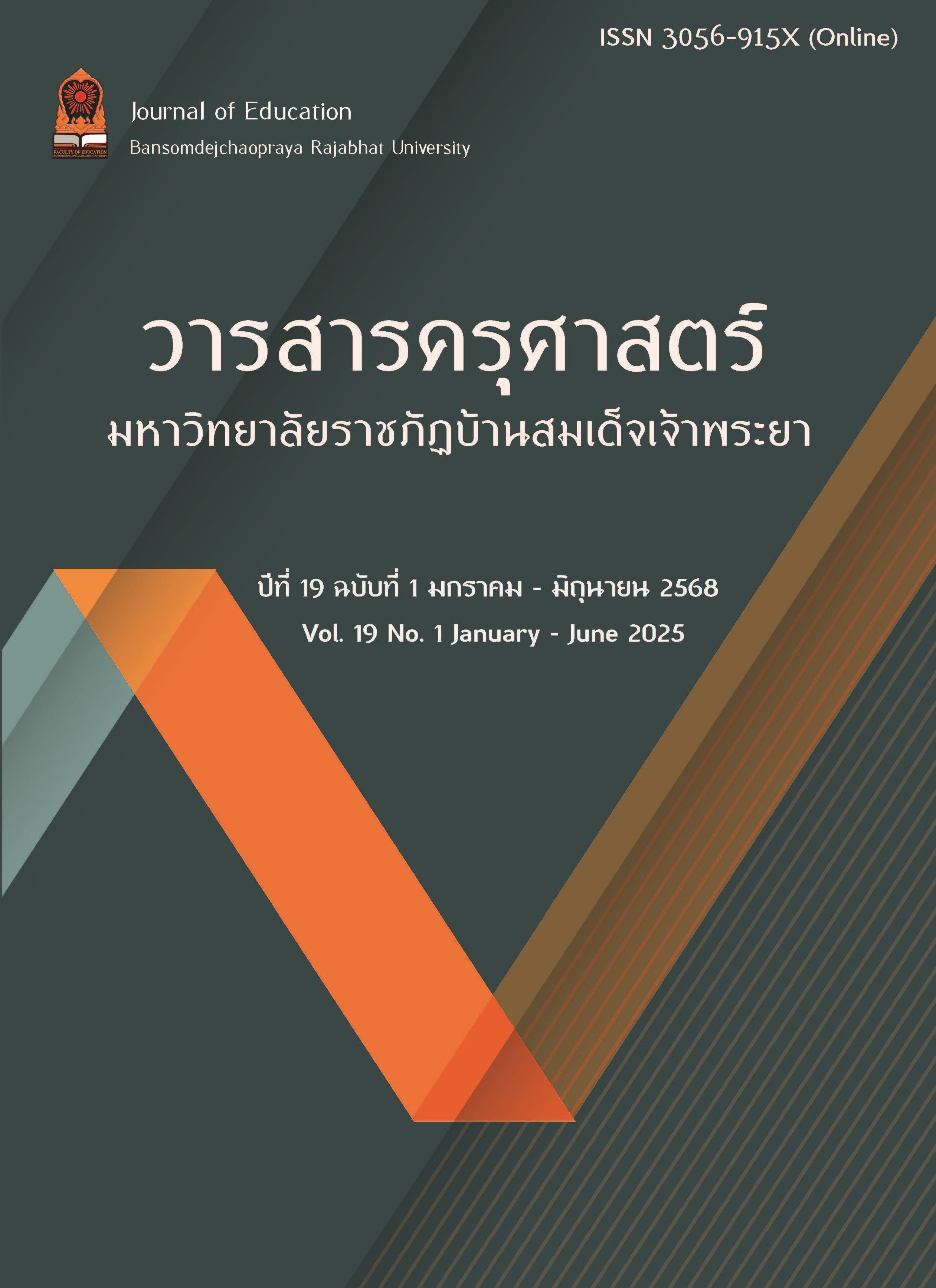The Effects of STEAM Education on Scientific Creativity and Science Learning Achievement of Grade 3 Students
Keywords:
scientific creativity, STEAM education, learning achievementAbstract
This research aimed to study the effects of STEAM education by: 1) comparing the scientific creativity and science learning achievement scores before and after learning, and 2) examining the development of scientific creativity among the students. The samples consisted of 30 Grade 3 students from a demonstration school in Thonburi district, Bangkok, during the second semester of the 2023 academic year, using cluster sampling. This research is a pre-experimental reseaech study using a one-group pretest-posttest design. The research tools included: 1) STEAM education lesson plans in the learning unit "Energy on our Earth" 2) a scientific creativity test, and 3) a science learning achievement test. The data were analyzed using mean, standard deviation, frequency, percentage of students by scientific creativity levels before learning and after learning, t-test for dependent samples, and scientific creativity developmental scores.
The research results revealed that:
1. The students’ scientific creativity scores in overall and each component after learning with STEAM education were higher than before learning with STEAM education at the .05 statistical significance level.
2. The students' development of scientific creativity was mostly at the moderate level, accounting for 43.3 %.
3. The students' science learning achievement mean score after learning with STEAM education was higher than before at the .05 statistical significance level.
Downloads
References
วรรณพร สิงห์บุญ, นวลจิตต์เชาวกีรติพงศ์ และดวงเดือน สุวรรณจินดา. (2564). ผลการจัดการเรียนรู้แบบสะตีมศึกษาที่มีต่อผลสัมฤทธิ์ทางการเรียนเรื่อง สารในชีวิตประจำวัน และความคิดสร้างสรรค์ทางวิทยาศาสตร์ สำหรับนักเรียนชั้นประถมศึกษาปีที่ 6 กลุ่มโรงเรียนปู่เจ้าสมิงพราย จังหวัดสมุทรปราการ. วารสารศึกษาศาสตร์ปริทัศน์, 36(3), 146-162.
สถาบันส่งเสริมการสอนวิทยาศาสตร์และเทคโนโลยี. (2565). มาตรฐานการเรียนรู้และตัวชี้วัด (ฉบับปรับปรุง พ.ศ. 2560) ตามหลักสูตรแกนกลางการศึกษาขั้นพื้นฐาน พุทธศักราช 2551. เข้าถึงได้จาก https://www.ipst.ac.th/
สมรัก อินทวิมลศรี, สกลรัชต์ แก้วดี และสิทธิพร ภัทรดิลกรัตน์. (2562). ผลของการใช้แนวคิดสะตีมศึกษาในวิชาชีววิทยาที่มีต่อความคิดสร้างสรรค์ทางวิทยาศาสตร์ และผลสัมฤทธิ์ทางการเรียนของนักเรียนชั้นมัธยมศึกษาปีที่ 4. วารสารครุศาสตร์ปริทรรศน์, 47(2), 410-429. เข้าถึงได้จาก https://so02.tci-thaijo.org/index.php/EDUCU/article/view/196409.
อรอุมา ดิษกิ่งสะแกราช. (2565). ผลการใช้กิจกรรมค่ายวิทยาศาสตร์ตามแนวสะเต็มศึกษาที่มีต่อความคิดสร้างสรรค์ทางวิทยาศาสตร์ของนักเรียนชั้นประถมศึกษาตอนปลาย. (วิทยานิพนธ์การศึกษามหาบัณฑิต). กรุงเทพฯ: มหาวิทยาลัยศรีนคริทรวิโรฒ.
Hu, W., & Adey, P. (2002). A scientific creativity test for secondary school students. International Journal of Science Education, 24(4), 389-403.
Harackiewicz, J., Durik, A., Barron, K., Linnenbrink-Garcia, L., & Tauer, J. (2008). The role of achievement goals in the development of Interest: Reciprocal relations between achievement goals, interest, and performance. Journal of Educational Psychology, 100, 105-122.
Hu, W., Adey, P., Shi, Q. Z., Han, Q., & Wang, X. (2010). Creative scientific problem finding and its developmental trend. Creativity Research Journal, 22(1), 46-52. Retrieved from https://www.tandfonline.com/doi/full/10.1080/1040041090 3579551
Siew, N. M., Chong, C. L., & Chin, K. O. (2014). Developing a scientific creativity test for fifth graders. Journal Article Problems of Education in the 21st Century, 62,109-123.
Riley, S. M. (2016). 6Steps to creating a STEAM classroom. Retrieved from https:// educationcloset.com/2016/02/25/6-steps-to-creating-a-steam-centered-classroom/
Raj, H., & Saxena, D. R. (2021).Scientific creativity: A review of researches. European Academic Research, IV, 1122-1138.
Yakman, G. (2008). STEAM Education: An Overview of Creating a Model of Integrative Education. In The Pupils’ Attitudes Towards Technology Conference. pp. 1-28.
Yang, X., Blagodatsky, S., Lippe, M., Liu, F., Hammond, J., Xu, J., & Cadisch, G. (2016). Land-use change impact on time-averaged carbon balances: Rubberexpansion and reforestation in a biosphere reserve, South-West China. Journal Forest Ecology and Management, 372(3), 149-163.
Downloads
Published
How to Cite
Issue
Section
License
Copyright (c) 2025 Faculty of Educaion Bansomdejchaopraya Rajabhat University

This work is licensed under a Creative Commons Attribution-NonCommercial-NoDerivatives 4.0 International License.
บทความที่ได้รับการตีพิมพ์เป็นลิขสิทธิ์ของคณะครุศาสตร์ มหาวิทยาลัยราชภัฏบ้านสมเด็จเจ้าพระยา
ข้อความที่ปรากฏในบทความแต่ละเรื่องในวารสารวิชาการเล่มนี้เป็นความคิดเห็นส่วนตัวของผู้เขียนแต่ละท่านไม่เกี่ยวข้องกับมหาวิทยาลัยราชภัฏบ้านสมเด็จเจ้าพระยา และคณาจารย์ท่านอื่นๆในมหาวิทยาลัยฯ แต่อย่างใด ความรับผิดชอบองค์ประกอบทั้งหมดของบทความแต่ละเรื่องเป็นของผู้เขียนแต่ละท่าน หากมีความผิดพลาดใดๆ ผู้เขียนแต่ละท่านจะรับผิดชอบบทความของตนเอง



